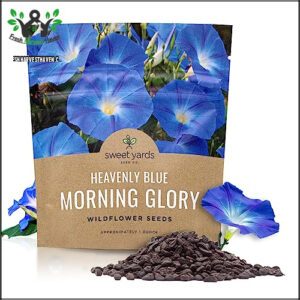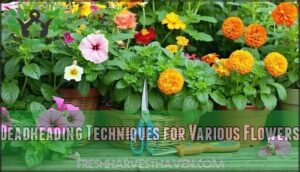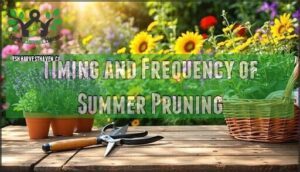This site is supported by our readers. We may earn a commission, at no cost to you, if you purchase through links.

Deep watering every few days builds stronger root systems than daily shallow sessions, while drip irrigation can save up to 90% of your water.
Apply 2-3 inches of organic mulch to keep roots cool and retain moisture.
Watch for drought stress signs like midday wilting and crispy leaf edges—these signal immediate irrigation needs.
Feed your flowers phosphorus-rich fertilizer every six weeks, avoiding excess nitrogen that promotes leaves over blooms.
Proper plant spacing makes certain adequate airflow, preventing fungal diseases while reducing water competition.
The secret lies in understanding that stressed plants aren’t just surviving—they’re missing critical flowering cues that separate thriving gardens from struggling ones.
Table Of Contents
- Key Takeaways
- Essential Summer Garden Care Tips
- Combatting Summer Pests and Diseases
- Deadheading and Pruning for Continuous Blooms
- Top Summer Flower Choices and Planting Strategies
- Giant Delphinium Seed Mix Pack
- Outsidepride 1000 Purple Gomphrena Globosa Flower Seeds
- Lantana Flower Seeds Mixed Colors 100 Plus Pack
- Heavenly Blue Morning Glory Flower Seeds
- Burpee Border Mix Geranium Seeds
- Replacing Spring Annuals With Heat-Loving Varieties
- Summer-Blooming Bulbs for Late-Season Color
- Caring for Perennials for Continued Blooms
- Frequently Asked Questions (FAQs)
- How to care for summer flowers?
- What is the rule of 3 in gardening?
- Should you water flowers everyday in the summer?
- When should you cut back summer flowers?
- How to take care of flowers in the summer?
- How often should I water my flower garden in summer?
- How to maintain the flower garden?
- Which flowers attract the most butterflies and hummingbirds?
- When is the best time to fertilize flowering plants?
- Can I move flowering plants during summer months?
- Conclusion
Key Takeaways
- Water deeply every 2-3 days in the early morning (5-9 AM) rather than daily shallow watering – this builds stronger root systems and reduces water waste by up to 90%
- Apply 2-3 inches of organic mulch around your plants to lock in moisture, regulate soil temperature, and reduce watering frequency during hot weather
- Deadhead spent blooms weekly and fertilize every 6 weeks with phosphorus-rich fertilizer to redirect energy into new flowers instead of seed production
- Watch for drought stress signs like midday wilting and crispy leaf edges, then provide immediate deep watering and consider afternoon shade during extreme heat waves
Essential Summer Garden Care Tips
Summer’s peak heat can stress even your toughest flowers, but proper care techniques will keep your garden blooming beautifully through the season.
Understanding water management, soil protection, and plant nutrition creates the foundation for vibrant summer displays that resist drought and maintain continuous color.
Watering Techniques for Hot Weather
Water your summer garden between 5 and 9 am when soil moisture retention peaks and evaporation stays minimal.
Deep watering every few days builds heat tolerance better than daily shallow sprinkles.
Use drip irrigation systems for 80-90% water conservation efficiency.
Check soil moisture regularly—stick your finger two inches down.
Smart drought management keeps your summer blooms thriving while preserving precious water resources.
Implementing proper water conservation methods is essential for a healthy summer garden.
Mulching for Moisture Conservation
Two to three inches of organic mulch creates a protective barrier that locks moisture into your garden soil while regulating soil temperature.
Organic mulch: nature’s moisture-locking shield that keeps your garden thriving through summer’s heat
This simple flower gardening tips strategy transforms summer garden care by reducing watering frequency and supporting healthier root systems through consistent moisture retention.
- Shredded bark mulch – Nature’s insulation blanket that keeps roots cool during scorching afternoons
- Compost-based mulch types – Living organic matter that feeds your flowers while they drink
- Straw or grass clippings – Free weed suppression that turns yesterday’s lawn care into today’s garden maintenance
- Wood chips – Long-lasting moisture retention that creates a spa-like environment for stressed plants
- Leaf mold – Yesterday’s fallen leaves become tomorrow’s water-saving superhero for garden soil
Effective summer garden planting techniques also emphasize the importance of maintaining ideal soil conditions to support healthy plant growth.
Recognizing Drought Stress in Plants
Drought stress manifests through distinct drought signs that every gardener should recognize.
Plant wilting occurs first during midday heat, followed by leaf edges turning brown or crispy.
Soil moisture levels drop substantially, creating hard, cracked surfaces, and heat tolerance varies among species.
Some flowers show immediate water scarcity effects, while others maintain appearance longer before displaying visible stress signals requiring immediate garden irrigation adjustments.
Fertilizing for Extended Blooms
Your plants need proper flower nutrition to maintain peak blooms through summer’s heat.
Phosphorus-rich fertilizer types like 10-10-10 blends act as bloom boosters, supporting continuous flowering.
Apply balanced growth enhancers every six weeks for soil enrichment, and avoid excess nitrogen, which promotes leaves over flowers.
Time-release fertilizers provide steady flower fertilization during summer gardening season, and for best results, consider summer fertilization techniques to support plant health.
Proper Plant Spacing and Airflow
Good plant density creates breathing room for your flowers while maximizing garden design potential.
Space plants according to their mature width, allowing adequate leaf clearance for air circulation.
This prevents fungal diseases and promotes healthy root growth in quality soil.
Proper spacing enhances flower care by reducing competition for nutrients and water during outdoor gardening activities like garden pruning and flower planting.
Combatting Summer Pests and Diseases
Summer heat brings unwelcome visitors to your flower garden, from aphids clustering on tender buds to fungal diseases thriving in humid conditions.
You’ll need targeted strategies to protect your blooms without harming beneficial insects or disrupting the natural garden ecosystem, using methods that preserve the balance of your garden ecosystem.
Common Summer Garden Pests
Summer heat creates perfect breeding conditions for destructive garden pests that can devastate your flower displays.
When summer heat strikes, hungry pests see opportunity while your flowers face their biggest challenge yet
Aphid populations explode in midsummer, infesting 60% of garden plots while transmitting over 50 plant viruses.
Whiteflies multiply rapidly, reaching hundreds per plant during warm spells.
Spider mites thrive in hot, dry conditions, causing stippling and leaf drop on 70% of susceptible species.
Early pest identification and garden care prevent these invaders from destroying your summer flowers, which is crucial for maintaining healthy flower displays.
Organic Pest Control Methods
Why settle for harsh chemicals when nature provides effective alternatives?
Neem oil disrupts feeding and reproduction in over 200 pest species, reducing aphid populations within 2-4 weeks.
Companion plants like marigolds and alliums naturally repel garden pests by up to 40%.
Biological control through beneficial insects decreases pest populations by 34-90%, while organic sprays and eco-friendly pest traps offer targeted solutions for summer flowers.
For best results, consider using a neem oil spray as part of your integrated pest management strategy.
Preventing Diseases Through Proper Care
Healthy plants resist flower diseases better than stressed ones.
Proper garden watering creates ideal conditions while preventing fungal control problems.
Space plants adequately for airflow, promoting root health and reducing bacterial management issues.
Regular soil testing identifies nutrient deficiencies affecting plant growth and agriculture.
Practice sanitation methods by removing debris and disinfecting tools to maintain garden beauty and prevent disease spread in your flower arrangement, ensuring proper garden care.
Biological Pest Control Solutions
Beyond disease prevention, nature provides your garden’s best defense force through biological pest control solutions.
Deploy beneficial insects like ladybugs and praying mantises to patrol flower beds, controlling aphids and whiteflies without harming pollinators during summer’s peak growing season.
- Natural Predators – Release ladybugs, lacewings, and predatory mites to hunt harmful pests while protecting flower health
- Pest Traps – Install sticky traps and pheromone lures to monitor and reduce flying insect populations around blooms
- Organic Sprays – Apply neem oil or insecticidal soap during cooler evening hours to minimize environmental impact
- Beneficial Insects – Plant companion flowers like marigolds and cosmos to attract helpful pollinators and pest controllers
- Microbial Control – Use Bacillus thuringiensis (Bt) sprays to target specific caterpillars without affecting garden watering schedules
Effective summer gardening also involves understanding organic pest control methods to guarantee a thriving flower garden.
Deadheading and Pruning for Continuous Blooms
You’ll maximize your garden’s blooming potential through strategic deadheading and proper pruning techniques throughout the summer months.
Regular removal of spent flowers redirects the plant’s energy from seed production back into creating fresh blooms, extending your flowering season by several weeks, which is a result of effective pruning.
Deadheading Techniques for Various Flowers
Flower trimming becomes your secret weapon for bloom prolongation throughout the summer season.
You’ll pinch petunias and marigolds with your fingertips, while tougher stems like roses require sharp scissors.
Cut spent blooms just above healthy leaves to redirect plant growth energy. This petal removal prevents seed formation, encouraging continuous flowering.
Clean tools prevent disease transmission during your gardening routine, which is crucial for maintaining healthy plants and achieving successful bloom.
Pinching Back for Bushy Growth
Pinching back growing tips during summer sunshine encourages Bushy Growth by redirecting energy to side shoots.
Use your fingers for Leaf Pinching on soft stems, or clean shears for Stem Cutting on woody plants.
This Plant Pruning technique works best before heatwaves stress your garden.
Focus on leggy annuals and perennials showing sparse Plant Growth and Agriculture benefits from regular pinching sessions.
Timing and Frequency of Summer Pruning
Proper timing transforms your pruning schedules from guesswork into precision. Early to mid-summer, particularly before August, provides the sweet spot for most summer trimming activities. This window allows plants to recover and potentially rebloom before autumn’s arrival.
- Peak Performance Window: Mid to late July offers ideal prune timing for encouraging second blooms in perennials
- Temperature Considerations: Avoid pruning during extreme heatwaves when plants experience additional stress from high sunshine exposure
- Recovery Factor: Most garden maintenance tasks show best results when completed during moderate temperature periods rather than peak season heat
Supporting Tall or Leaning Plants
Tall plants often topple during summer’s intense temperature swings and growth spurts.
Install Plant Stakes early in the season before stems thicken. Garden Supports prevent root damage from late installation.
Bamboo stakes work well for most flowers, while metal supports handle heavier perennials. Tie stems loosely with soft material for Stem Reinforcement without restricting Growth Management.
Proper Lean Prevention keeps your garden upright through summer’s climate challenges. Effective soil health maintenance is also essential for preventing plant toppling and promoting overall garden stability.
Top Summer Flower Choices and Planting Strategies
Choosing the right flowers transforms your summer garden into a continuous display of vibrant blooms that thrive in hot weather conditions.
You’ll need heat-tolerant varieties and proper planting techniques to maintain colorful displays from June through September, creating a beautiful and thriving garden with vibrant blooms.
Giant Delphinium Seed Mix Pack

When establishing delphiniums from seed, you’ll discover these towering beauties require specific Delphinium Care techniques for successful Seed Germination.
Plant seeds in late summer when temperature drops below 70°F, as cool climate conditions trigger ideal plant growth.
These spectacular spikes enhance Garden Design with six-foot heights, creating dramatic Flower Arrangements.
Apply consistent Blooming Tips including deep watering and staking during the growing season.
Delphiniums thrive in agriculture zones 3-7, rewarding patient gardeners with magnificent summer displays.
Outsidepride 1000 Purple Gomphrena Globosa Flower Seeds

Purple gomphrena globosa transforms your summer garden into a vibrant tapestry. These globe-shaped purple blooms thrive in warm weather, requiring minimal soil preparation and basic gardening tools. Seed germination occurs within 14-21 days when temperatures reach 70-75°F.
Their drought tolerance makes them perfect for heat-stressed areas during the season.
- Plant Growth: Space seeds 6-8 inches apart for ideal air circulation
- Heat Tolerance: Withstands temperatures up to 95°F without wilting
- Flower Arrangements: Cut stems last 7-10 days in bouquets
- Agriculture Benefits: Attracts beneficial pollinators while deterring harmful insects
Lantana Flower Seeds Mixed Colors 100 Plus Pack

Lantana’s vibrant blooms create stunning flower arrangements with remarkable color variations spanning yellow, orange, red, and pink hues.
These heat-tolerant champions thrive in summer’s intense conditions, demonstrating exceptional plant hardiness in USDA zones 8-11.
Proper seed storage maintains viability for three years when kept cool and dry.
| Growing Characteristic | Specification |
|---|---|
| Seed Germination Time | 14-21 days at 70°F |
| Plant Growth Height | 12-36 inches tall |
| Seasonal Changes | Continuous blooms until frost |
| Climate Requirements | Full sun, drought tolerance |
Heavenly Blue Morning Glory Flower Seeds

Morning glory seeds thrive through easy seed germination in warm summer soil, producing vibrant blue flower color from June through frost.
These climbing vines prefer well-draining soil preference and full sun exposure. Their vigorous growth habits create natural screens reaching 6-10 feet during the blooming period.
Plant growth accelerates with seasonal changes as temperatures rise consistently above 65°F throughout the growing season. Morning glory seeds can be described as having easy seed germination and vibrant blue flower color.
Burpee Border Mix Geranium Seeds

These reliable container stars deliver consistent blooms throughout the summer season with minimal Geranium Care requirements.
Start Seed Starting indoors 10-12 weeks before last frost for best Plant Growth results.
The compact border varieties excel in Flower Arrangements and Garden Design applications.
Prepare well-draining Soil Preparation with organic matter, as geraniums thrive in various Climate and Seasons conditions across different Geography and Latitude zones.
Replacing Spring Annuals With Heat-Loving Varieties
As summer heat intensifies, your spring annuals may wilt and struggle.
Replace cool-season flowers with Heat Tolerant Plants that thrive in scorching temperatures.
Marigolds, zinnias, and celosia offer vibrant Summer Blooms through the hottest months.
This Garden Renewal strategy guarantees continuous color when Warm Season Flowers take center stage.
Strategic Flower Replacement maximizes your garden’s potential during peak summer heat.
Summer-Blooming Bulbs for Late-Season Color
Bulbs planted during the summer months offer gardeners a strategic advantage for extending Garden Design beyond typical spring displays.
These Late Bloomers, including gladiolus and dahlias, thrive in heat and temperature conditions that challenge other plants.
When selecting varieties for Flower Arrangements, consider Color Schemes that complement existing plant growth patterns.
Proper Bulb Care involves planting in well-draining soil and maintaining consistent moisture throughout the season.
This approach guarantees vibrant blooms when other agriculture displays begin declining, creating sustained visual interest in your garden’s climate-adapted layout.
By following a summer flower planting guide, gardeners can make informed decisions about heat-resistant flowers and ideal soil preparation.
Caring for Perennials for Continued Blooms
Your perennials need strategic Perennial Care to maintain peak performance throughout the summer season.
Apply fertilizer 6-8 weeks after spring growth resumes to support Bloom Prolongation during intense Heat and Temperature fluctuations.
Deadhead spent flowers on coneflowers and phlox to redirect energy into new blooms.
Deep watering twice weekly promotes robust Plant Growth and Agriculture practices while improving Soil Quality.
This Flower Maintenance approach guarantees Garden Renewal despite challenging Climate conditions.
Frequently Asked Questions (FAQs)
How to care for summer flowers?
Botanical research confirms proper watering techniques substantially impact flower longevity.
Water deeply every few days rather than daily shallow irrigation.
Apply organic mulch, deadhead spent blooms, and fertilize perennials six weeks after initial growth resumes.
What is the rule of 3 in gardening?
The rule of three in gardening suggests planting in odd-numbered groups, typically threes, for more natural and visually appealing arrangements.
You’ll create better balance and avoid the rigid, formal look that even-numbered plantings often produce, which is a key aspect of achieving a more natural look.
Should you water flowers everyday in the summer?
Daily watering drowns roots while deep watering every few days builds resilience.
You’ll promote stronger root systems by watering thoroughly but less frequently, allowing soil to partially dry between sessions during summer’s heat, which helps build resilience.
When should you cut back summer flowers?
You’ll cut back summer flowers at different times depending on your goal.
Deadhead spent blooms throughout the season to encourage more flowers.
For perennials, cut back after flowering ends or wait until fall cleanup, this can be considered a complete concept for managing them.
How to take care of flowers in the summer?
Like tending a fragile kingdom, you’ll nurture summer blooms through strategic watering, deadheading spent flowers, applying mulch for moisture retention, and providing afternoon shade during extreme heat waves.
How often should I water my flower garden in summer?
Water your flowers deeply every 2-3 days rather than daily shallow watering.
This encourages strong root development and drought resilience.
Check soil moisture by inserting your finger 2 inches deep—if dry, it’s time to water.
How to maintain the flower garden?
Your garden’s like a stage requiring consistent performances—deadhead spent blooms weekly, apply deep watering twice per week, mulch around plants, stake tall varieties, and fertilize perennials every six weeks for continuous flowering.
Which flowers attract the most butterflies and hummingbirds?
Vibrant red cardinal flowers, bee balm, and zinnias create butterfly and hummingbird havens.
Bee balm attracts all pollinators, including butterflies and hummingbirds, while zinnias bloom until frost and are excellent plants that attract hummingbirds and butterflies .
When is the best time to fertilize flowering plants?
You’ll achieve best results fertilizing flowering plants early spring when growth begins, then applying a second dose 6-8 weeks later to maintain blooming throughout the season.
Can I move flowering plants during summer months?
Like Sisyphus pushing his boulder, you can relocate flowering plants, but summer’s heat makes it challenging.
Choose early morning or evening for transplanting.
Water thoroughly before and after moving. Expect temporary wilting and reduced blooming.
Conclusion
Mastering summer flower garden care transforms seasonal challenges into opportunities for spectacular displays.
By implementing proper watering schedules, strategic mulching, and targeted fertilization, you’ll create resilient gardens that flourish despite heat stress.
Remember that consistent care practices prevent most common problems before they begin.
Monitor your plants closely for early warning signs, maintain adequate spacing for airflow, and stay proactive with pest management.
Your dedication to these proven techniques guarantees continuous blooms throughout the hottest months, rewarding you with vibrant colors and healthy growth all season long.
- https://www.gardenary.com/blog/the-ultimate-guide-to-summer-gardening
- https://chesapeakelandscape.net/blog/summer-watering-tips/
- https://www.wagnergreenhouses.com/blog/summer-watering-tips-2/
- https://www.umass.edu/agriculture-food-environment/home-lawn-garden/fact-sheets/fertilizing-flower-garden-plants
- https://www.thecelticfarm.com/fertilizer-schedule-calendar/











